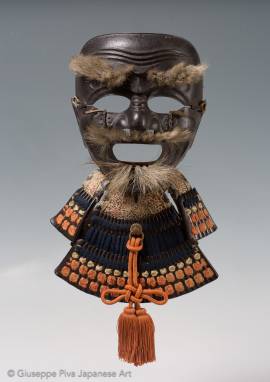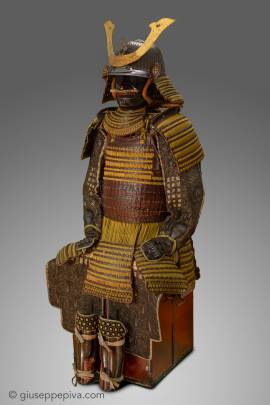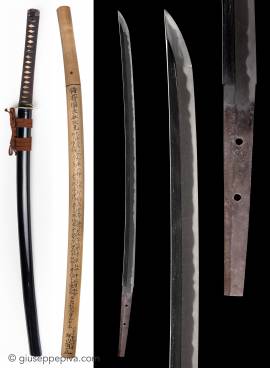Okina SōmenA full face russet iron samurai amour’s mask formed and decorated to resemble the face of an old manEdo period, 18th centuryArmor for the face - mengu - developed towards the end of the Muromachi Period (1336- 1573) with the double role of protection and a fastening point for the kabuto ropes through hooks or rings. However, masks that completely cover the face were never common, as not very practical, and their spread was restricted to high-ranking samurai who could wear them for official occasions as an indication of their social status. For this reason original sōmen are...
WORKS FOR SALE
Dangae-dō tosei gusokuSamurai armor with a mixed styles cuirass PERIODMid Edo period (1615-1868), 18th century The armor shows an unknown family crest on its helm and on the backs of the hands (tekko).The components of the armor are upholstered with leather, which has been applied also to the ligatures of the lower part of the cuirass (produced with iyo-zane plates) using a more rare manufacturing than the common lacquer trims.The sixty-two plate helm (kabuto) is of type suji bachi, and it is covered in black lacquer, as well as the mask (menpo) and the three limb...
MumeiNanbokuchō Period (1333-1392), circa 1360NBTHK Jūyō Tōken-Nagasa [length]: 69.6 cmSori [curvature]: 1.4 cmMotohaba [bottom width]: 3 cmSakihaba [top width]: 2.3 cmMotokasane [bottom thickness]: 2 mm-Sugata [configuration]: Shinogi-zukuri, maru-mune. The blade is wide, with a slight difference between top and bottom, thick kasane, high shinogi, slightly deep sori, ō-kissaki (5.6 cm)Kitae [forging pattern]: Itame hada mixed with frequent mokume hadatachi. Jinie, fine chikei, pale utsuriHamon [tempering pattern]: Ko-notare mixed with ko-gunome, kaku-gunome, ko-choji and togarigokoro....
Copyright © 2016 - giuseppe piva - VAT: 05104180962










